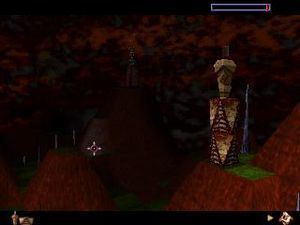9.6 /10 1 Votes
Initial release date 1998 | 4.8/5 Discogs Developer Hookstone | |||||||||||||||||||||||||||||||||
 | ||||||||||||||||||||||||||||||||||
Mode(s) Single player, Multiplayer Similar Psygnosis games, Puzzle video games | ||||||||||||||||||||||||||||||||||
Sentinel Returns is a video game developed by Hookstone, produced by No-Name Games and published by Sony (under the Psygnosis label) in 1998, for PC and PlayStation. It is the sequel to The Sentinel by Geoff Crammond and features 651 levels, a multiplayer mode and a soundtrack (titled "Earth/Air") composed by John Carpenter and arranged by Gary McKill.
Contents
- Ramagamma plays sentinel returns 1998 psx
- Game mechanics
- Game mechanics differences from the predecessor
- Graphical differences between PC and PlayStation version
- References

The PC version has native support limited to a software display mode and an accelerated Glide mode, because in 1998, 3DFX cards were the de facto standard for gaming 3D graphics. However, modern computers can run the game in accelerated mode with the wrappers nGlide, dgVoodoo, OpenGlide or zeckensack's Glide wrapper, which translate Glide calls respectively into Direct3D or OpenGL calls.

This game looks very different from its predecessor. While in The Sentinel the levels were bright and colorful, in Sentinel Returns they are dark and gloomy, with flashes of light being emitted when an object is created or absorbed, and the mouse pointer dynamically lighting the world. The game has a general "hallucinated" look: the skies are made out of contrasting streaks of color; the trees look like sperms; the boulders breathe and have a sphincter on the top; the sentinels and sentries are hybrids of flesh and metal; the sentinel stands are covered with skin and have four vertebral columns protruding from the corners; the "specimen" representing the living part of the synthoid resembles a hydatidiform mole, and it squirms and lets out a shriek when injected with a needle.

Ramagamma plays sentinel returns 1998 psx
Game mechanics

Controlling Synthoids that are standing at a higher level is fundamental to the game, because only the objects which occupy a visible square can be interacted with (the player may absorb or create objects on a boulder if the sides can be seen). While doing so, the player must watch for the rotation of the Sentinel and be careful not to stand in an area which the Sentinel can see, or else it will start absorbing energy from the Synthoid, and when the energy is gone, the game is over.
Height is gained by placing a boulder on any visible square, and putting a Synthoid on the boulder. The player may then transfer consciousness to the new Synthoid, and absorb the old one. Stacks of boulders of any height may be created, if the player has enough energy. In order to absorb the Sentinel, the player must create a stack of boulders of sufficient height that the Synthoid on top can look down on the Sentinel's platform. When the Sentinel has been absorbed, the player may no longer absorb any energy from the landscape, although objects may be created as normal.
In later levels, the Sentinel is assisted by a number of Sentries. They behave exactly like the Sentinel, but absorbing them is not necessary to complete the level. Unlike the Sentinel, the Sentries do not stand on a platform but on ordinary squares. Attention must also be paid to nearby trees: if the Sentinel or Sentry cannot see the square the Synthoid is standing on, but its head is visible and there are trees in the vicinity, it may transform one of them into a Meanie, which will force the Synthoid to hyperspace and lose 3 units of energy. If the Meanie itself cannot see the player's square after a full rotation, it will turn back into a tree and the Sentinel or Sentry will resume rotation.
The rotation of the Sentinel and the Sentries is slow and predictable. However, if there are many Sentries, there will be few safe locations anywhere on the landscape. If either the Sentinel or the Sentries come across a source of energy (boulders or a synthoid), their rotation stops while they absorb the energy, one unit at a time. Meanwhile, to keep the total energy of the landscape constant, a tree is created randomly on the landscape for each absorbed unit of energy.
List of objects that can exist in the Sentinel world:
A level is won by absorbing the Sentinel off its platform, creating a new Synthoid in the place of the Sentinel, transferring the consciousness to it and hyperspacing to a new level.
The number of levels that are skipped between two that are played depends on the amount of energy the player has accumulated when he jumps into hyperspace: absorbing less than 50% of the total energy present in a level will skip a level; absorbing between 50% and 69% will skip two; absorbing between 70% to 89% will skip three; absorbing between 90% and 100% will skip four.
Game mechanics differences from the predecessor
Graphical differences between PC and PlayStation version
Although their gameplay is almost identical, the two versions have several differences in their graphical look.
